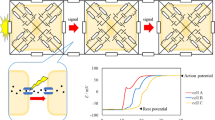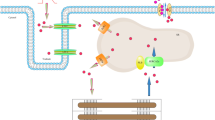Abstract
This study was designed to examine the effect of infrasound exposure (5 Hz at 130 dB) on whole-cell L-type Ca2+ currents (WLCC) in rat ventricular myocytes and the underlying mechanism(s) involved. Thirty-two adult Sprague-Dawley rats were randomly assigned to infrasound exposure and control groups. [Ca2+]i, WLCC, mRNA expression of the a1c subunit of L-type Ca2+ channels (LCC), and SERCA2 protein were examined on day 1, 7, and 14 after initiation of infrasound exposure. Fluo-3/AM fluorescence and the laser scanning confocal microscope techniques were used to measure [Ca2+]i in freshly isolated ventricular myocytes. The Ca2+ fluorescence intensity (FI), denoting [Ca2+]i in cardiomyocytes, was significantly elevated in a time-dependent manner in the exposure groups. There was a significant increase in WLCC in the 1-day group and a further significant increase in the 7- and 14-day groups. LCC mRNA expression measured by RT-PCR revealed a significant rise in the 1-day group and a significant additional rise in the 7- and 14-day groups compared with control group. SERCA2 expression was significantly upregulated in the 1-day group followed by an overt decrease in the 7- and 14-day groups. Prolonged exposure of infrasound altered WLCC in rat cardiomyocytes by shifting the steady-state inactivation curves to the right (more depolarized direction) without altering the slope and biophysical properties of I Ca,L. Taken together, our data suggest that changes in [Ca2+]I levels as well as expression of LCC and SERCA2 may contribute to the infrasound exposure-elicited cardiac response.





Similar content being viewed by others
References
Pei, Z., Sang, H., Li, R., Xiao, P., He, J., Zhuang, Z., et al. (2007). Infrasound-induced hemodynamics, ultrastructure, and molecular changes in the rat myocardium. Environmental Toxicology, 22, 169–175. doi:10.1002/tox.20244.
Nekhoroshe, A. S., & Glinchikov, V. V. (1991). Morphofunctional changes in the myocardium under exposure to infrasound. NVB Noise and Vibration Bulletin, 12, 15–17.
Chen, J. Z., Pei, Z. H., Zhu, M. Z., Zhuang, Z. Q., Pei, J. M., & Liu, J. (2005). Effects of infrasound of 8 Hz at 90 dB on the ultra-structure of myocardium. Chinese Heart Journal, 17, 216–217.
Yamasumi, Y., Shiraishi, T., Miyashita, K., Kuroda, M., Luo, W., & Taniuchi, T. S. (1994). The pituitary adrenocortical response in rats exposed to fluctuating infrasound. Journal of Low Frequency Noise and Vibration, 13, 89–93.
Slarve, R. N., & Johnson, D. L. (1975). Human whole body exposure to infrasound. Aviation, Space and Environmental Medicine, 46, 428–431.
Liu, Z. H., Chen, J. Z., Tang, Y., Chen, D., Ding, G. R., Liu, J., et al. (2004). Effects of infrasound on changes of intracellular calcium ion concentration and on expression of RyRs in hippocampus of rat brain. Journal of Low Frequency Noise and Vibration, 23, 159–165. doi:10.1260/0263092042863618.
Bers, D. M., & Perez-Reyes, E. (1999). Ca2+ channels in cardiac myocytes: Structure and function in Ca influx and intracellular Ca2+ release. Cardiovascular Research, 42, 339–360. doi:10.1016/S0008-6363(99)00038-3.
Maclennan, D. H. (1970). Purification and properties of an adenosine triphosphatase from sarcoplasmic reticulum. The Journal of Biological Chemistry, 245, 4508–4518.
Walsh, K. B., & Long, K. J. (1992). Inhibition of heart calcium and chloride currents by sodium iodide. Specific attenuation in cAMP-dependent protein kinase-mediated regulation. The Journal of General Physiology, 100, 847–865. doi:10.1085/jgp.100.5.847.
Walsh, K. B., & Parks, G. E. (2002). Changes in cardiac myocyte morphology alter the properties of voltage-gated ion channels. Cardiovascular Research, 55, 64–75. doi:10.1016/S0008-6363(02)00403-0.
Hamill, O. P., Marty, A., Neher, E., Sakmann, B., & Sigworth, J. (1981). Improved patch-clamp techniques for high resolution current recordings from cells and cell-free membrane patches. Pflügers Archiv, 391, 85–100. doi:10.1007/BF00656997.
Wijetunge, S., Lymn, J. S., & Hughes, A. D. (2000). Effects of protein tyrosine kinase inhibitors on voltage-operated calcium channel currents in vascular smooth muscle cells and pp60 (c-src) kinase activity. British Journal of Pharmacology, 129, 1347–1354. doi:10.1038/sj.bjp.0703186.
Inui, M., Wang, S., Saito, A., & Fleischer, S. (1998). Characterization of junctional and longitudinal sarcoplasmic reticulum from heart muscle. The Journal of Biological Chemistry, 263, 10843–10850.
Sánchez, G., Hidalgo, C., & Donoso, P. (2003). Kinetic studies of calcium-induced calcium release in cardiac sarcoplasmic reticulum vesicles. Biophysical Journal, 84, 2319–2330. doi:10.1016/S0006-3495(03)75037-1.
Zhuang, Z. Q., Pei, Z. H., & Chen, J. Z. (2007). Infrasound-induced changes on sexual behavior in male rats and some underlying mechanism. Environmental Toxicology and Pharmacology, 23, 111–114. doi:10.1016/j.etap.2006.07.009.
Fei, Z., Zhang, X., Li, Z. G., Liu, E. Y., Bai, H. M., Chen, J. Z., et al. (2001). The changes and significance of TXA2 and PGI2 metabolism after rat infrasonic brain damage. Journal of Low Frequency Noise and Vibration, 20, 33–37. doi:10.1260/0263092011492966.
Fei, Z., Zhang, X., Wang, X. F., Li, Z. G., Lu, L., Liu, X. Z., et al. (2000). The changes of rat blood-brain barrier permeability and expression of heat shock protein 70 after infrasonic damage. Journal of Low Frequency Noise and Vibration, 19, 93–99. doi:10.1260/0263092001492840.
Hudman, D., Rainbow, R. D., Lawrence, C. L., & Standen, N. B. (2002). The origin of calcium overload in rat cardiac myocytes following metabolic inhibition with 2,4-dinitrophenol. Journal of Molecular and Cellular Cardiology, 34, 859–871. doi:10.1006/jmcc.2002.2024.
Xia, M., Salat, J. J., Figueroa, D. J., Lawlor, A. M., Liang, H. A., Liu, Y., et al. (2004). Functional expression of L- and T-type Ca2+ channels in murine HL-1 cells. Journal of Molecular and Cellular Cardiology, 36, 111–119. doi:10.1016/j.yjmcc.2003.10.007.
Andrzej, M., Janczewski, H. A., & Spurgeon, E. G. (2002). Action potential prolongation in cardiac myocytes of old rats is an adaptation to sustain youthful intracellular Ca2+ regulation. Journal of Molecular and Cellular Cardiology, 34, 641–648. doi:10.1006/jmcc.2002.2004.
Thomas, N., Rana, M. T., Ken-ichi, K., & Naranjan, S. D. (2002). Ca2+-overload inhibits the cardiac SR Ca2+–calmodulin protein kinase activity. Biochemical and Biophysical Research Communications, 293, 727–732. doi:10.1016/S0006-291X(02)00287-5.
Xu, A. T., Netticadan, D. L., & Jones, N. N. (1999). Serine phosphorylation of the sarcoplasmic reticulum Ca2+-ATPase in the intact beating rabbit heart. Biochemical and Biophysical Research Communications, 264, 241–246. doi:10.1006/bbrc.1999.1491.
Konrad, F. F., Birgit, B., Erland, E., & Robert, H. G. (2003). Sarcoplasmic reticulum Ca-ATPase modulates cardiac contraction and relaxation. Cardiovascular Research, 57, 20–27. doi:10.1016/S0008-6363(02)00694-6.
Acknowledgment
This work was supported by the National Natural Science Foundation of China (Grant: 30870579).
Author information
Authors and Affiliations
Corresponding author
Additional information
Zhaohui Pei and Zhiqiang Zhuang contributed equally to this work.
Rights and permissions
About this article
Cite this article
Pei, Z., Zhuang, Z., Xiao, P. et al. Influence of Infrasound Exposure on the Whole L-type Calcium Currents in Rat Ventricular Myocytes. Cardiovasc Toxicol 9, 70–77 (2009). https://doi.org/10.1007/s12012-009-9037-3
Received:
Accepted:
Published:
Issue Date:
DOI: https://doi.org/10.1007/s12012-009-9037-3




